翻译学导论
- 格式:docx
- 大小:91.86 KB
- 文档页数:6
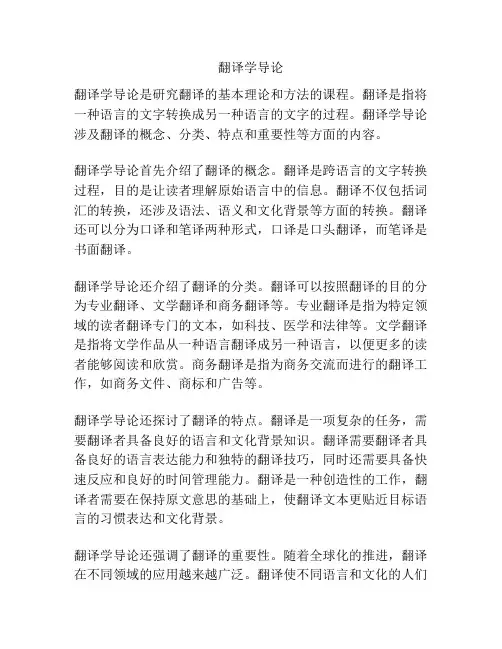
翻译学导论翻译学导论是研究翻译的基本理论和方法的课程。
翻译是指将一种语言的文字转换成另一种语言的文字的过程。
翻译学导论涉及翻译的概念、分类、特点和重要性等方面的内容。
翻译学导论首先介绍了翻译的概念。
翻译是跨语言的文字转换过程,目的是让读者理解原始语言中的信息。
翻译不仅包括词汇的转换,还涉及语法、语义和文化背景等方面的转换。
翻译还可以分为口译和笔译两种形式,口译是口头翻译,而笔译是书面翻译。
翻译学导论还介绍了翻译的分类。
翻译可以按照翻译的目的分为专业翻译、文学翻译和商务翻译等。
专业翻译是指为特定领域的读者翻译专门的文本,如科技、医学和法律等。
文学翻译是指将文学作品从一种语言翻译成另一种语言,以便更多的读者能够阅读和欣赏。
商务翻译是指为商务交流而进行的翻译工作,如商务文件、商标和广告等。
翻译学导论还探讨了翻译的特点。
翻译是一项复杂的任务,需要翻译者具备良好的语言和文化背景知识。
翻译需要翻译者具备良好的语言表达能力和独特的翻译技巧,同时还需要具备快速反应和良好的时间管理能力。
翻译是一种创造性的工作,翻译者需要在保持原文意思的基础上,使翻译文本更贴近目标语言的习惯表达和文化背景。
翻译学导论还强调了翻译的重要性。
随着全球化的推进,翻译在不同领域的应用越来越广泛。
翻译使不同语言和文化的人们能够相互交流和理解,促进了国际合作和交流。
翻译还促进了文化交流和文化多样性的发展。
翻译在经济、政治、教育和文化领域都具有重要的作用。
综上所述,翻译学导论是学习翻译理论和方法的基础课程。
通过学习翻译的概念、分类、特点和重要性等内容,学生能够了解翻译的基本知识和技巧,为今后的翻译工作打下基础。
此外,翻译学导论还培养了学生的跨文化交流和理解能力,提升了学生的语言表达和沟通能力,对于培养综合素质和提高国际竞争力具有重要意义。
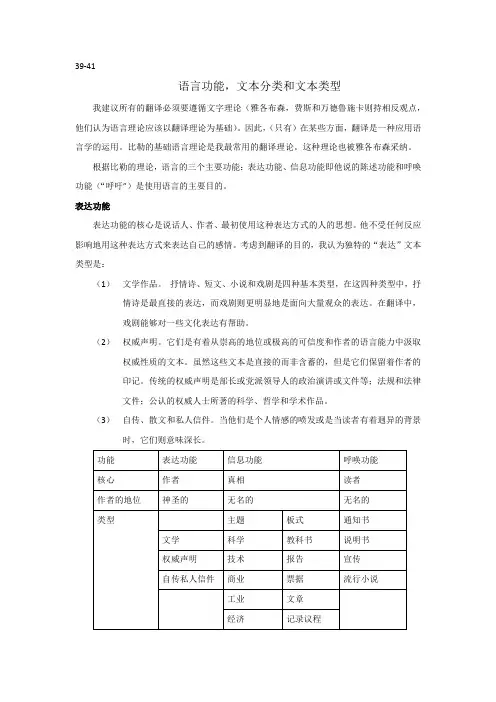
39-41语言功能,文本分类和文本类型我建议所有的翻译必须要遵循文字理论(雅各布森,费斯和万德鲁施卡则持相反观点,他们认为语言理论应该以翻译理论为基础)。
因此,(只有)在某些方面,翻译是一种应用语言学的运用。
比勒的基础语言理论是我最常用的翻译理论。
这种理论也被雅各布森采纳。
根据比勒的理论,语言的三个主要功能:表达功能、信息功能即他说的陈述功能和呼唤功能(“呼吁”)是使用语言的主要目的。
表达功能表达功能的核心是说话人、作者、最初使用这种表达方式的人的思想。
他不受任何反应影响地用这种表达方式来表达自己的感情。
考虑到翻译的目的,我认为独特的“表达”文本类型是:(1)文学作品。
抒情诗、短文、小说和戏剧是四种基本类型,在这四种类型中,抒情诗是最直接的表达,而戏剧则更明显地是面向大量观众的表达。
在翻译中,戏剧能够对一些文化表达有帮助。
(2)权威声明。
它们是有着从崇高的地位或极高的可信度和作者的语言能力中汲取权威性质的文本。
虽然这些文本是直接的而非含蓄的,但是它们保留着作者的印记。
传统的权威声明是部长或党派领导人的政治演讲或文件等;法规和法律文件;公认的权威人士所著的科学、哲学和学术作品。
(3)自传、散文和私人信件。
当他们是个人情感的喷发或是当读者有着迥异的背景时,它们则意味深长。
作为一名译者,能够区分出这些文本里的私人要素对你很重要。
这些要素为特殊(少见的)搭配,有创意的比喻,不可译的词语、特别是必须翻成一到两个或是三个的性质形容词,非常规的语法,新词,生疏词(古语、方言、奇怪的科学术语)——所有的这些经常被描绘成为‘个人方言’或是‘私人语言’——与日常语言相对,即股票用语和隐喻、常见的搭配、正常的语法、口语化的表达和phaticisms——常见的语言套路。
个人因素组成了一篇表达型文本中的表达成分(只是一部分),在翻译时你不应该将它们变为日常语言。
(看第二部分,正文第三部分中关于表达的段落。
)信息功能语言的信息功能的核心为包括报道的观点或理论在内的外部状况,主题的真相,语言外的现实。
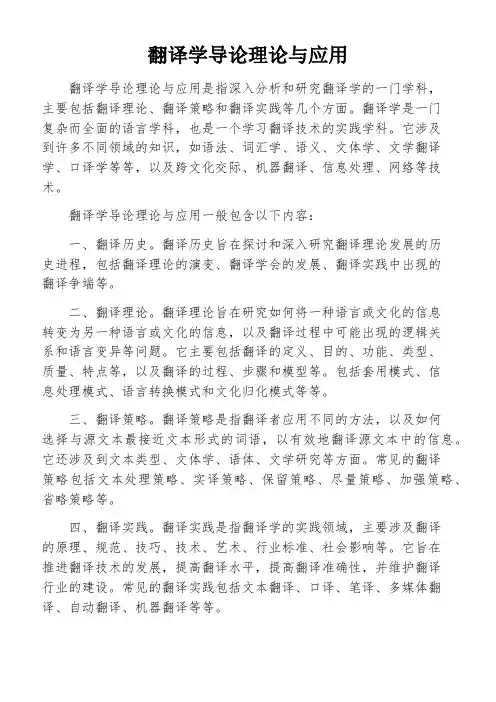
翻译学导论理论与应用翻译学导论理论与应用是指深入分析和研究翻译学的一门学科,主要包括翻译理论、翻译策略和翻译实践等几个方面。
翻译学是一门复杂而全面的语言学科,也是一个学习翻译技术的实践学科。
它涉及到许多不同领域的知识,如语法、词汇学、语义、文体学、文学翻译学、口译学等等,以及跨文化交际、机器翻译、信息处理、网络等技术。
翻译学导论理论与应用一般包含以下内容:一、翻译历史。
翻译历史旨在探讨和深入研究翻译理论发展的历史进程,包括翻译理论的演变、翻译学会的发展、翻译实践中出现的翻译争端等。
二、翻译理论。
翻译理论旨在研究如何将一种语言或文化的信息转变为另一种语言或文化的信息,以及翻译过程中可能出现的逻辑关系和语言变异等问题。
它主要包括翻译的定义、目的、功能、类型、质量、特点等,以及翻译的过程、步骤和模型等。
包括套用模式、信息处理模式、语言转换模式和文化归化模式等等。
三、翻译策略。
翻译策略是指翻译者应用不同的方法,以及如何选择与源文本最接近文本形式的词语,以有效地翻译源文本中的信息。
它还涉及到文本类型、文体学、语体、文学研究等方面。
常见的翻译策略包括文本处理策略、实译策略、保留策略、尽量策略、加强策略、省略策略等。
四、翻译实践。
翻译实践是指翻译学的实践领域,主要涉及翻译的原理、规范、技巧、技术、艺术、行业标准、社会影响等。
它旨在推进翻译技术的发展,提高翻译水平,提高翻译准确性,并维护翻译行业的建设。
常见的翻译实践包括文本翻译、口译、笔译、多媒体翻译、自动翻译、机器翻译等等。
总结起来,翻译学导论理论与应用是一门研究翻译理论历史、研究翻译理论、研究翻译策略和翻译实践的学科。
它旨在推进翻译技术的发展,提高翻译水平,以及提高翻译行业的建设。

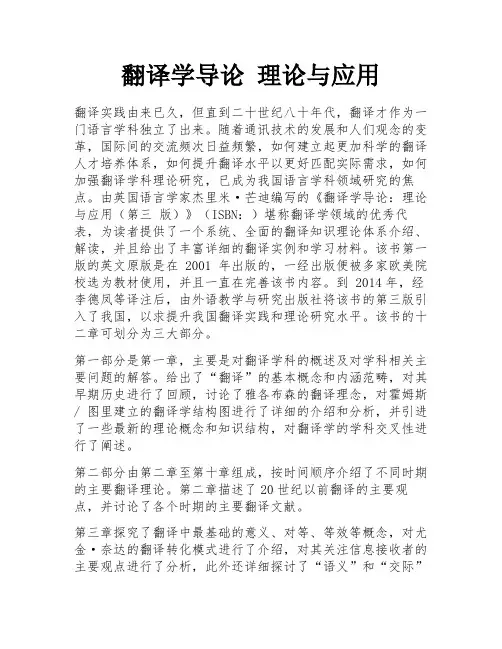
翻译学导论理论与应用翻译实践由来已久,但直到二十世纪八十年代,翻译才作为一门语言学科独立了出来。
随着通讯技术的发展和人们观念的变革,国际间的交流频次日益频繁,如何建立起更加科学的翻译人才培养体系,如何提升翻译水平以更好匹配实际需求,如何加强翻译学科理论研究,已成为我国语言学科领域研究的焦点。
由英国语言学家杰里米·芒迪编写的《翻译学导论:理论与应用(第三版)》(ISBN:)堪称翻译学领域的优秀代表,为读者提供了一个系统、全面的翻译知识理论体系介绍、解读,并且给出了丰富详细的翻译实例和学习材料。
该书第一版的英文原版是在 2001 年出版的,一经出版便被多家欧美院校选为教材使用,并且一直在完善该书内容。
到 2014年,经李德凤等译注后,由外语教学与研究出版社将该书的第三版引入了我国,以求提升我国翻译实践和理论研究水平。
该书的十二章可划分为三大部分。
第一部分是第一章,主要是对翻译学科的概述及对学科相关主要问题的解答。
给出了“翻译”的基本概念和内涵范畴,对其早期历史进行了回顾,讨论了雅各布森的翻译理念,对霍姆斯/ 图里建立的翻译学结构图进行了详细的介绍和分析,并引进了一些最新的理论概念和知识结构,对翻译学的学科交叉性进行了阐述。
第二部分由第二章至第十章组成,按时间顺序介绍了不同时期的主要翻译理论。
第二章描述了20世纪以前翻译的主要观点,并讨论了各个时期的主要翻译文献。
第三章探究了翻译中最基础的意义、对等、等效等概念,对尤金·奈达的翻译转化模式进行了介绍,对其关注信息接收者的主要观点进行了分析,此外还详细探讨了“语义”和“交际”两种翻译概念,依次对其中的“对等”内涵进行了解析。
第四章主要是对前人在描述翻译产品及翻译过程研究中取得成绩的介绍,包括有语言变化的影响等,给出了一些“语言转换”的分类理论和语言学模式,并从认知的角度对翻译过程进行了研究,解释了翻译过程中信息处理及语言交际是如何实现的。
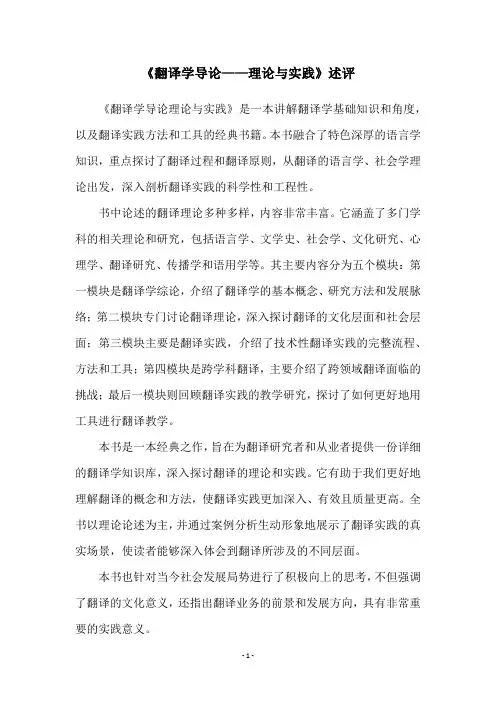
《翻译学导论——理论与实践》述评
《翻译学导论理论与实践》是一本讲解翻译学基础知识和角度,以及翻译实践方法和工具的经典书籍。
本书融合了特色深厚的语言学知识,重点探讨了翻译过程和翻译原则,从翻译的语言学、社会学理论出发,深入剖析翻译实践的科学性和工程性。
书中论述的翻译理论多种多样,内容非常丰富。
它涵盖了多门学科的相关理论和研究,包括语言学、文学史、社会学、文化研究、心理学、翻译研究、传播学和语用学等。
其主要内容分为五个模块:第一模块是翻译学综论,介绍了翻译学的基本概念、研究方法和发展脉络;第二模块专门讨论翻译理论,深入探讨翻译的文化层面和社会层面;第三模块主要是翻译实践,介绍了技术性翻译实践的完整流程、方法和工具;第四模块是跨学科翻译,主要介绍了跨领域翻译面临的挑战;最后一模块则回顾翻译实践的教学研究,探讨了如何更好地用工具进行翻译教学。
本书是一本经典之作,旨在为翻译研究者和从业者提供一份详细的翻译学知识库,深入探讨翻译的理论和实践。
它有助于我们更好地理解翻译的概念和方法,使翻译实践更加深入、有效且质量更高。
全书以理论论述为主,并通过案例分析生动形象地展示了翻译实践的真实场景,使读者能够深入体会到翻译所涉及的不同层面。
本书也针对当今社会发展局势进行了积极向上的思考,不但强调了翻译的文化意义,还指出翻译业务的前景和发展方向,具有非常重要的实践意义。
总之,《翻译学导论理论与实践》是一本从理论到实践的经典书籍,它能够为翻译行业的研究者和从业者提供全面、系统的学习方法,帮助我们更好地把握翻译的整体结构,快速搞清翻译实践中的原则和工具,使我们能够更有效、更有质量地完成翻译任务。
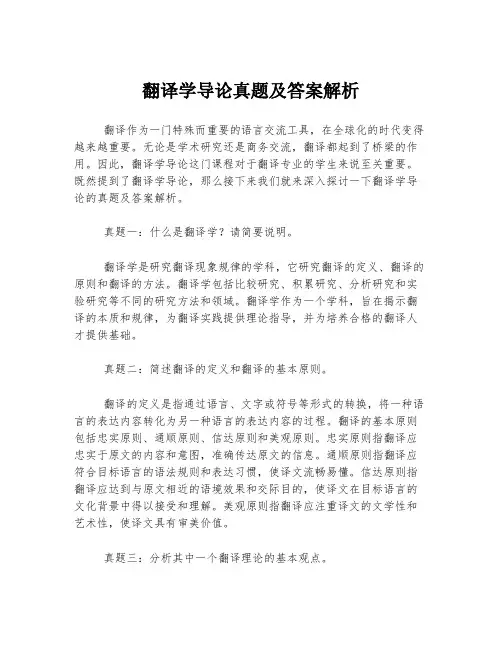
翻译学导论真题及答案解析翻译作为一门特殊而重要的语言交流工具,在全球化的时代变得越来越重要。
无论是学术研究还是商务交流,翻译都起到了桥梁的作用。
因此,翻译学导论这门课程对于翻译专业的学生来说至关重要。
既然提到了翻译学导论,那么接下来我们就来深入探讨一下翻译学导论的真题及答案解析。
真题一:什么是翻译学?请简要说明。
翻译学是研究翻译现象规律的学科,它研究翻译的定义、翻译的原则和翻译的方法。
翻译学包括比较研究、积累研究、分析研究和实验研究等不同的研究方法和领域。
翻译学作为一个学科,旨在揭示翻译的本质和规律,为翻译实践提供理论指导,并为培养合格的翻译人才提供基础。
真题二:简述翻译的定义和翻译的基本原则。
翻译的定义是指通过语言、文字或符号等形式的转换,将一种语言的表达内容转化为另一种语言的表达内容的过程。
翻译的基本原则包括忠实原则、通顺原则、信达原则和美观原则。
忠实原则指翻译应忠实于原文的内容和意图,准确传达原文的信息。
通顺原则指翻译应符合目标语言的语法规则和表达习惯,使译文流畅易懂。
信达原则指翻译应达到与原文相近的语境效果和交际目的,使译文在目标语言的文化背景中得以接受和理解。
美观原则指翻译应注重译文的文学性和艺术性,使译文具有审美价值。
真题三:分析其中一个翻译理论的基本观点。
以函数对等理论为例,它表明翻译是一种功能性的语言活动,旨在实现某种特定的语义等价关系。
函数对等理论认为翻译是一种详细的函数关系,将源语言中的输入值(原文)映射到目标语言中的输出值(译文)。
在这一理论中,翻译被视为是一种无损转化的过程,要求译文与原文在语义上保持等价,即传达相似的语义信息。
这一理论强调语言层面的功用性,将翻译视为一种对等关系,并强调在翻译过程中保持语义的一致性。
真题四:通过一个案例分析翻译中的文化因素。
举一个例子,中国传统的“寿”一词,在英语中通常直接翻译为“longevity”,但这并不能完全传达其文化含义。
在中国文化中,寿是一种吉祥的象征,代表长寿和幸福。
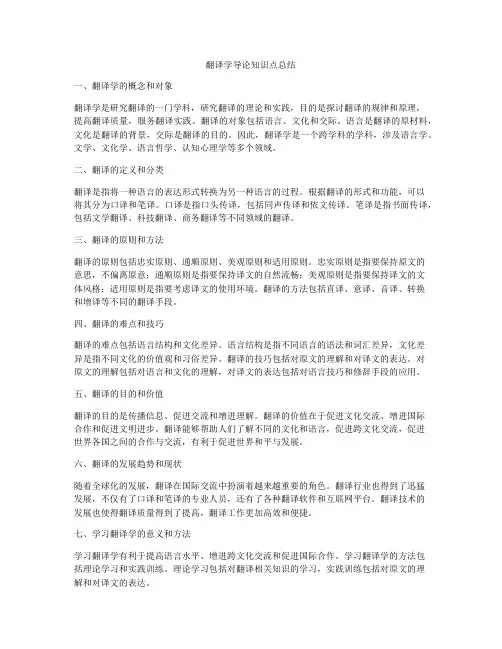
翻译学导论知识点总结一、翻译学的概念和对象翻译学是研究翻译的一门学科,研究翻译的理论和实践,目的是探讨翻译的规律和原理,提高翻译质量,服务翻译实践。
翻译的对象包括语言、文化和交际。
语言是翻译的原材料,文化是翻译的背景,交际是翻译的目的。
因此,翻译学是一个跨学科的学科,涉及语言学、文学、文化学、语言哲学、认知心理学等多个领域。
二、翻译的定义和分类翻译是指将一种语言的表达形式转换为另一种语言的过程。
根据翻译的形式和功能,可以将其分为口译和笔译。
口译是指口头传译,包括同声传译和依文传译。
笔译是指书面传译,包括文学翻译、科技翻译、商务翻译等不同领域的翻译。
三、翻译的原则和方法翻译的原则包括忠实原则、通顺原则、美观原则和适用原则。
忠实原则是指要保持原文的意思,不偏离原意;通顺原则是指要保持译文的自然流畅;美观原则是指要保持译文的文体风格;适用原则是指要考虑译文的使用环境。
翻译的方法包括直译、意译、音译、转换和增译等不同的翻译手段。
四、翻译的难点和技巧翻译的难点包括语言结构和文化差异。
语言结构是指不同语言的语法和词汇差异,文化差异是指不同文化的价值观和习俗差异。
翻译的技巧包括对原文的理解和对译文的表达。
对原文的理解包括对语言和文化的理解,对译文的表达包括对语言技巧和修辞手段的应用。
五、翻译的目的和价值翻译的目的是传播信息、促进交流和增进理解。
翻译的价值在于促进文化交流、增进国际合作和促进文明进步。
翻译能够帮助人们了解不同的文化和语言,促进跨文化交流,促进世界各国之间的合作与交流,有利于促进世界和平与发展。
六、翻译的发展趋势和现状随着全球化的发展,翻译在国际交流中扮演着越来越重要的角色。
翻译行业也得到了迅猛发展,不仅有了口译和笔译的专业人员,还有了各种翻译软件和互联网平台。
翻译技术的发展也使得翻译质量得到了提高,翻译工作更加高效和便捷。
七、学习翻译学的意义和方法学习翻译学有利于提高语言水平、增进跨文化交流和促进国际合作。
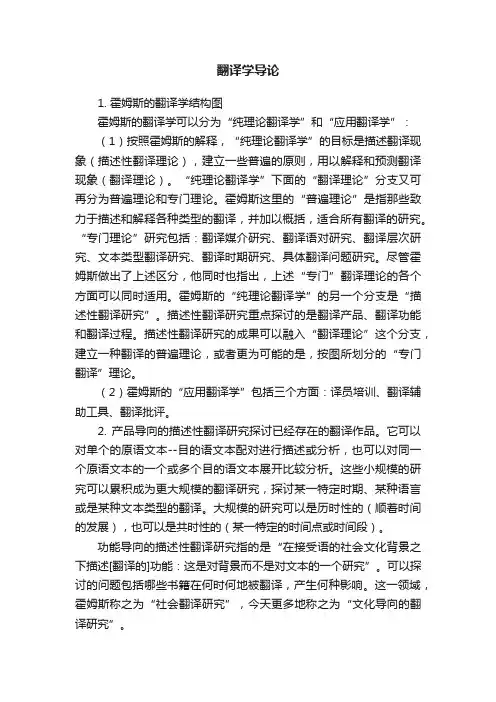
翻译学导论1. 霍姆斯的翻译学结构图霍姆斯的翻译学可以分为“纯理论翻译学”和“应用翻译学”:(1)按照霍姆斯的解释,“纯理论翻译学”的目标是描述翻译现象(描述性翻译理论),建立一些普遍的原则,用以解释和预测翻译现象(翻译理论)。
“纯理论翻译学”下面的“翻译理论”分支又可再分为普遍理论和专门理论。
霍姆斯这里的“普遍理论”是指那些致力于描述和解释各种类型的翻译,并加以概括,适合所有翻译的研究。
“专门理论”研究包括:翻译媒介研究、翻译语对研究、翻译层次研究、文本类型翻译研究、翻译时期研究、具体翻译问题研究。
尽管霍姆斯做出了上述区分,他同时也指出,上述“专门”翻译理论的各个方面可以同时适用。
霍姆斯的“纯理论翻译学”的另一个分支是“描述性翻译研究”。
描述性翻译研究重点探讨的是翻译产品、翻译功能和翻译过程。
描述性翻译研究的成果可以融入“翻译理论”这个分支,建立一种翻译的普遍理论,或者更为可能的是,按图所划分的“专门翻译”理论。
(2)霍姆斯的“应用翻译学”包括三个方面:译员培训、翻译辅助工具、翻译批评。
2. 产品导向的描述性翻译研究探讨已经存在的翻译作品。
它可以对单个的原语文本--目的语文本配对进行描述或分析,也可以对同一个原语文本的一个或多个目的语文本展开比较分析。
这些小规模的研究可以累积成为更大规模的翻译研究,探讨某一特定时期、某种语言或是某种文本类型的翻译。
大规模的研究可以是历时性的(顺着时间的发展),也可以是共时性的(某一特定的时间点或时间段)。
功能导向的描述性翻译研究指的是“在接受语的社会文化背景之下描述[翻译的]功能:这是对背景而不是对文本的一个研究”。
可以探讨的问题包括哪些书籍在何时何地被翻译,产生何种影响。
这一领域,霍姆斯称之为“社会翻译研究”,今天更多地称之为“文化导向的翻译研究”。
过程导向的描述性翻译研究和翻译的心理学有关,它主要致力于挖掘译者大脑中所发生的事情。
虽然后来有些研究者在朗声思维(译者在翻译时将他们的翻译过程叙述出来,研究者对译者的叙述进行录音)方面做了一些研究,但这一领域至今仍然缺乏系统的分析。
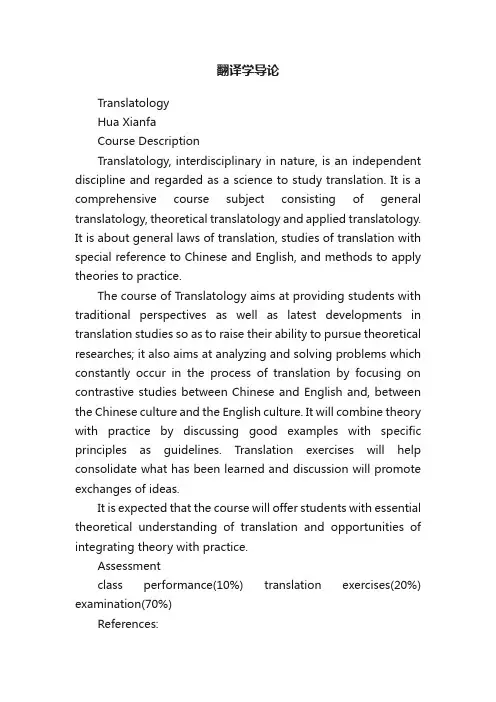
翻译学导论TranslatologyHua XianfaCourse DescriptionTranslatology, interdisciplinary in nature, is an independent discipline and regarded as a science to study translation. It is a comprehensive course subject consisting of general translatology, theoretical translatology and applied translatology. It is about general laws of translation, studies of translation with special reference to Chinese and English, and methods to apply theories to practice.The course of Translatology aims at providing students with traditional perspectives as well as latest developments in translation studies so as to raise their ability to pursue theoretical researches; it also aims at analyzing and solving problems which constantly occur in the process of translation by focusing on contrastive studies between Chinese and English and, between the Chinese culture and the English culture. It will combine theory with practice by discussing good examples with specific principles as guidelines. Translation exercises will help consolidate what has been learned and discussion will promote exchanges of ideas.It is expected that the course will offer students with essential theoretical understanding of translation and opportunities of integrating theory with practice.Assessmentclass performance(10%) translation exercises(20%) examination(70%)References:[1]Baker, Mona. In Other Words: A Coursebook on Translation[M]. London and New York:Routledge, 1992.[2]Baker, Mona. The Routledge Encyclopedia of Translation Studies[Z], London and New York:Routledge, 1997.[3]Chan, Tak-hung. Twentieth-Century Chinese Translation Theory: Modes, issues anddebates[M], Benjamins Translation Library, 2004.[4]House, J. Translation Quality Assessment: A Model Revisited[M], Tübingen: Niemeyer, 1997.[5]Munday, Jeremy. Introducing Translation Studies[M]. London: Routledge, 2001.[6]Newmark, P. A. Textbook of Translation[M]. London: Prentice Hall International(UK)Ltd. 1988[7]Newmark, P.A. Approaches to Translation[M]. London: Prentice Hall International(UK)Ltd.1988.[8]Nida, E.A. Language, Culture and Translating[M]. Shanghai: Shanghai ForeignLanguage Education Press, 1993.[9]Snell-Hornby, Mary. Translation Studies: An Integrated Approach[M]. ShanghaiForeign Language Education Press, 2001.[10]陈宏薇、李亚丹.新编汉英翻译教程[Z],上海:上海外语教育出版社,2004.[11]郭延礼. 中国近代翻译文学概论[Z], 武汉:湖北教育出版社,1998.[12]华先发、邵毅.新编大学英译汉教程[Z],上海:上海外语教育出版社,2004.[13]李定坤. 汉英辞格对比与翻译[Z],武汉:华中师范大学出版社,1994.[14]李瑞华. 英汉语言文化对比研究[C],上海:上海外语教育出版社,1997.[15]谭载喜. 翻译学[M], 武汉:湖北教育出版社,2000.[16]许均. 翻译论[M],武汉:湖北教育出版社,2003.Chapter I General TranslatologyGeneral translatology addresses the description of the phenomena of translation by focusing on such issues as the definition of translation, the nature of translation, types of translation, criteria of translation, procedures of translation, and disciplines related to translation and studies.1.1 What is translation?Different perspectives on the nature of translatingTranslation can be defined from different perspectives, which present to us different definitions:A. From the perspective of the process of the action itself:In the light of popular orientation (in dictionaries and encyclopedias), translation is to express (sth spoken or esp written) in another language or in simple words. (Hornby, A.S. OALECD 4th ed. 2000)Eugene Nida: Translating consists in reproducing in the receptor language the closest natural equivalent of the source language message, first in terms of meaning and secondly in terms of style. (1969:12)John Catford: Translation may be defined as follows: The replacement of textual material in one language (SL) by equivalent textual material in another language (TL). (1965:20) The central problem of translation practice is that of finding TLtranslation equivalents. A central task of translation theory is that of defining that nature and conditions of translation equivalence. (1965:21)Bahudarov: Translation is a process in which the parole of one language is transferred into the parole of another with the content i.e. meaning unchanged.Peter Newmark: Translation what is translation? Often, though not by any means always, it is rendering the meaning of a text into another language in the way that the author intended the text. (1988:5)B. From the perspective of the function of translation:Steiner: Translation it is that openeth the window, to let in the light; that breaketh the shell, that we may eat the kernel.Peter Newmark:Translation is an instrument of education as well as of truth precisely because it has to reach readers whose cultural and educational level is different from, and often “lower” or earlier, than that of the reader of the original. (1988:6) Peter Newmark: Translation has its own excitement, its own interest. A satisfactory translation is always possible, but a good translator is never satisfied with it. It can usually be improved. There is no such thing as a perfect ideal or …correct? translation.C.From the perspective of aesthetics:Malcolm Cowley: Translation is an art that involves the recreation of a work in another language for readers with a different background.D. From the perspective of the nature of translation:Peter Newmark: Translation is first a science, which entails the knowledge and verification of the facts and the language that describes them—here, what is wrong, mistaken or truth, can be identified; secondly, it is a skill, which calls for appropriatelanguage and acceptable usage; thirdly, an art, which distinguishes good from undistinguished writing and is the creative, the intuitive, sometimes the inspired, level of the translation; lastly, a matter of taste, where argument ceases, preferences are expressed, and the variety of meritorious translations is the reflection of individual differences. (1988:6)E. From the perspective of cross-cultural communicationJin Di & Nida: Translation is simply a form of interlingual communication.(1987)1.2 Types of translationTranslation can also be classified from different angles by different people.A. From the standpoint of signs involved in translation:Roman Jacobson: interlingual translation, intralingual translation, intersemiotic translation (interpretation of verbal signs by means of none verbal signs ) (On Linguistic Aspects of Translation)B. From the standpoint of way in which translation is carried out:Written interlingual translationOral interlingual transltionMachine translationC. From the standpoint of the extent to which translation is done:Full translation(absolute translation), partial translation (selective translation) , translation plus editing(translation with reconstruction)D. From the standpoint of the level of translationtotal translation (translation equivalence can be established at the same grammatical or phonological hierarchy)restricted translation (translation equivalence can be established at only one grammatical hierarchy)E. From the standpoint of the languages involved in translationtranslation from the native language into the foreign language or vice versa1.3 Criteria of translationAlexander F. TytlerA translation should give a complete transcript of the ideas of the original work; the style and manner of writing should be of the same character as that of the original; a translation should have all the ease of the original composition. (Tytler, 1797, P.15) John CatfordThe SL and TL rarely have …the same meaning? in the linguistic sense; but they can function in the same situation.For translation equivalence to occur, then both SL and TL texts must be relatable to the functionally relevant features of the situation.FedorovThe exactness of translation means the exact rendering of the thought and content of the original and performs the same rhetorical function as the original.Nidafunctional equivalenceThe crucial problem of translation is often stated in terms of conflict between formal correspondence and functional equivalence.A close formal correspondence in a receptor language so frequently does not carry the correct meaning of the source text. In some cases, formal correspondence doesn?t work , thenfunctional equivalence should take its place.There are five cases in which formal correspondence should be given up:1)When a literal rendering would give an entirely wrong meaning.2)When a borrowed term constitutes a semantic …zero? and is therefore likely to be filled with the wrong meaning.3)When a formal correspondence involves a serous obscurity in meaning.4)When formal correspondence would result in bad grammar or style in the receptor language.(Waard, Han, De & E.A. Nida)SavoryDifferent languages have different ways for expression, but all of them have an underlying equivalent thought.The translator faces the question as to whether his function is to record the words of the original or to report on their meanings.Gregory RabassaSo our criterion must state that the best translation is the closest approach.A translation can never equal the original; it can approach it, and its quality can only be judged by how close it gets.There are no two snowflakes alike.Yan Fufaithfulness, expressiveness and eleganceQian Zhongshusublimation the transmigration of souls “Although the body changes, the s oul of gesture remains its old self.”Fu LeiAs far as the effect is concerned, translation should be like copying a painting. What is desired is not being alike in appearance but being alike in spirit.Lu XunThe minimum requirement for general translation should at least convey faithfully the content of the original with understandable smooth translation, but this is not enough for literary translation… In literary translation, the artistic conception of the original is transmitted in another language so that when he is reading the translation, the reader can be inspired, touched and aesthetically affected the same as the if he were reading the original.Liu Zhongdefaithfulness, expressiveness and closeness1.4 Translation strategies and techniquesA. Translation strategiesChinese: 文and 质literal translation:word for word and line for line; keeping both the form and the content liberal/free translation: scarifying the form while keeping the content and spirit Schleiermacher: alienating and naturalizationEither the translator leaves the writer alone as much as possible and moves the reader toward the writer, or he [sic] leaves the reader alone as much as possible and moves the writer toward the reader. (Schleiermacher 1813/1992:41-42) Venuti: domestication and foreignizationDomestication: Domestication covers adherence to domestic literary canons by carefully selecting the texts that are likely to lend themselves to such a translation strategy(Venuti,1997:241) Foreignization: Foreignization entails choosing a foreign text anddeveloping a translation method along lines which are excluded by dominant cultural values in the target language.(Venuti, 1997:242)John Dryden: metaphrase, paraphrase and imitationB. Translation techniquestransliteration, annotation, paraphrase, amplification, omission, shift of perspective, adaptation,division, combination, specification, and generalization (华先发、邵毅,2004)1.5 The basic procedures of translationThe basic procedures of translation employed in translating consist of preparation, working and testing. Preparation refers to such matters as choosing what to be translated and contacting the publisher. Working includes both comprehension and expression. And testing is the final step taken to check the result of the work.1.5.1 Comprehension consists essentially in determining the meaning of the source language tex t, but …meaning? is to be interprete d in the broad sense of lexical, syntactic and rhetorical significance. It involves such steps as grammatical analysis, semantic analysis, stylistic analysis and discourse analysis. In other words, both form and content must be considered in comprehension.A. ComprehensionBe careful in determining the meaning of the words, phrases and sentences.(1)月明星稀,乌鹊南飞(曹孟德)(2) 若崩厥角稽首(孟子尽心下)(3) Mrs. Malaprop said, ”As she grew up, I would have her instructed in Geometry, that she might know something of thecontagious countries.” (R.B.Sheridan: The Rivals) (geometry[几何学]=geography[地理学]; contagious[传染的]=contiguous[邻近的])(4) “We sometimes fall in with persons who have seen much of the world, and of the men who, in their day, have played a conspicuous part in it, but who generalize nothing, and have no observation, in the true sense of the word.” (J. H. Newman)(5)王先生昨天被偷了。

第一章翻译学的主要方面小结:翻译研究是一个相对较新的研究领域,近年来获得了迅猛发展。
翻译以前是作为语言学习的一种方法,或是比较文学、翻译工作坊和对比语言学课程的一部分。
这门新的学科在很大程度上应该归功于詹姆斯.霍姆斯,他在《翻译研究的名与实》一文中不但为该领域提供了一个名称,而且还规划了该学科的结构。
翻译理论研究、描述性翻译研究和应用翻译学是互相关联的,近年来都有发展,逐渐在翻译理论与翻译实践之间架起了一座桥梁。
1. 翻译实践历史悠久,翻译学却是一门新兴学科。
2. 翻译实践和翻译理论之间的割裂持续存在。
3. James S. Holmes的《翻译研究的名与实》(The name and nature of translation studies, 1988年才为人所知)被认为是翻译学的“成立宣言”4. 翻译可以指翻译研究领域、翻译产品(译本)或者翻译过程(产生译本的行为)5. 俄裔美国结构主义学家Roman Jakobson在《论翻译的语言学方面》提出三种翻译类型:语内翻译(intralingual),语际翻译(interlingual),符际翻译(intersemiotic)6. 翻译研究作为一个学术研究领域是最近50年的事,它被称为“翻译学translatology”多亏了James S. Holmes.7. 对翻译的探讨,从公元前1世纪的西塞罗、贺拉斯和公元4世纪的圣哲罗姆(《七十子希腊文本圣经》)就开始了,后者被翻译成拉丁文时所用的手法影响了其后的圣经翻译。
8. 18世纪晚期到20世纪60年代,语法-翻译教学法统治了中学语言学习(死记硬背外语的语法规则和结构),20世纪六七十年代,直接法或交际法兴起,语言学习摒弃对翻译的摒弃,翻译局限于高层次大学语言课程和专业译员培训。
9. 翻译也是对比分析(contrastive analysis)领域的一个研究方向。
10. 霍姆斯的“描述性翻译理论”探讨三个方面:翻译产品(已有译作,探讨特定时期、某种语言/文本类型的翻译),翻译功能(哪些书籍何时何地被翻译,何种影响),翻译过程(挖掘译者大脑中发生的事情)11. 翻译理论、描述性翻译研究和应用翻译学还是会互相影响的。
翻译学导论理论与应用
《翻译学导论:理论与应用》是一本关于翻译学的入门书,旨在介绍翻译学及其相关理论和实践技术的基本知识。
该书综合运用实例、图表和媒体等,讲授翻译学的继承内涵、语言技术、理论分析方法、文化背景和实际经验。
自20世纪初以来,翻译学已经变得越来越具有实践性。
目前,
它已经成为新闻、出版、广播、网络媒体等多个领域的重要工具。
翻译对于宣传政治信息,传播文化,开展社会经济活动,促进人文交流和技术进步等都发挥着重要作用。
《翻译学导论:理论与应用》以提升读者的翻译学实践能力为目的,介绍了翻译理论的基本概念,包括语言和语用、翻译过程和翻译技术、翻译质量和翻译实践。
它更加着重介绍和讨论翻译分析和诊断方法,以及翻译实践中的文化转换与语言转换。
为了能够让读者更好地掌握翻译学的各个方面,该书分为8章,涵盖了翻译的技术与理论、文化翻译、同声翻译、关系语言技术、信息翻译、自由翻译和译文分析七个主题。
每一章都包括许多实用的例子,以及详细的讨论和分析,使读者能够更好地理解翻译相关的原理。
此外,该书还包括大量案例研究,比如中英文译稿、英法文译稿等,让读者能够更深入地了解一些实际情况,进行更有价值的实践实践。
最后,该书提供了一些参考资料,帮助读者学习和进一步深入理解翻译学的各个方面。
总之,《翻译学导论:理论与应用》是一本关于翻译学的入门书,
涵盖了翻译学的基本理论和实践技术,让读者能够快速掌握翻译学的基础知识,并将这些知识应用于翻译实践。
通过本书,读者不仅能够学习翻译学,还能够培养出良好的语言技能,从而提高自身的翻译能力。
翻译学导论选读书目Selected Reading List in Translation Theory1. Gentzler, E. 1993 Contemporary Translation Theories,Lodon and New York: Routledge2. Nida, E. A. 1969 The Theory and Practice ofTranslation, Leiden: E.J.Brill3. Catford, T. G. 1965 A Linguistic Theory ofTranslation, London: Oxford University Press4. 巴尔胡达罗夫:《语言与翻译》,中国对外翻译出版公司,1985年5.陈福康;《中国译学理论史稿》,上海外语教育出版社,1996年6.黄振定:《翻译学:艺术论与科学论的统一》,上海外语教育出版社,2008年7.刘宓庆:《当代翻译理论》,书林出版有限公司,1993年8.谭载喜:《西方翻译简史》,中国对外翻译出版公司,1997年9.Basil Hatim. Communication Across Culture:Translation Theory and Contrastive TextLinguistics, 上海外语教育出版社,2001年10.Leo Hickey. The Pragmatics of Translation, 上海外语教育出版社,2001年11.Gideon Toury. Descriptive Translation Studies and Beyond, 上海外语教育出版社,2001年12.Snell-Hornby, M. 1988 Translation Studies: An Integrated Approach, Philadelphia and New York:Benjamins13.马祖毅:《中国翻译简史》,北京:中国对外翻译出版公司,199814. 黄振定:《翻译学导论》,北京外语教学与研究出版社,2009年15.谭载喜:《翻译学》,湖北教育出版社,2005年16.许钧:《翻译论》,湖北教育出版社,2003年17.Newmark, P. 1982 Approaches to Translation. Oxford: Pergoman18.Bell, R.T. 1991 Translation and Translating: Theory and Practice, Lodon and New York: Longman19.Wolfman Wilss. The Science of Translation: Problem and Methods, Shanghai: Shanghai Foreign Language Education Press, 200120.Nida, E.A. 1964 Toward a Science of Translation, Leiden:E.J.Brill21. ----1993 Language, Culture and Translating, Shanghai:Shanghai Foreign Language Education Press22. ----2001 Language and Culture: Contexts in TranslatingShanghai: Shanghai Foreign Language Education Press23. Steiner,G. 1975 After Babel: Aspects of Language andTranslation, London: Oxford University Press24.Eoyang, Eugene Chen. 1993. The Transparant Eye: Refletions on Translation, Chinese Literature and Comparative Poetics,Honolulu: Uiversity of Hawaii Press25.Malone, Joseph L. 1988. The Science of Linguistics in the Art of Translation, Albany: Stae University of New York Press 26.Snell-Hornby, Franz Pochhacker and Klaus Kaindl(eds.). 1994.27.John Benjamins Translation Studies: An Interdiscipline, Amsterdam:28.《翻译通讯》编辑部:《翻译研究论文集》,外语教学与研究出版社,1984年29.金褆:《等效翻译探索》,中国对外翻译出版公司,1997年30.刘重德:《文学翻译十讲》中国对外翻译出版公司,1991年31.罗新璋:《翻译论集》,商务印书馆,1984年32.王佐良、丁往道:《英语文体学引论》,外语教学与研究出版社,1985年33.许余龙:《对比语言学概论》,上海外语教育出版社,1992年34.许渊冲:《翻译的艺术》,中国对外翻译出版公司,1985年35.刘宓庆:《文体与翻译》,北京:中国对外翻译出版公司,1986年36.吕俊,侯向群:《英汉翻译教程》,上海外语教育出版社,2001年37. 吕俊、侯向群:《翻译批评学引论》,上海外语教育出版社,2009年38. 吕俊、侯向群:《翻译学:一个建构主义的视角》,上海外语教育出版社,2006年(实际计38部,前16部为必读和必考书目,余者为自选阅读书目)。
翻译学导论读书心得3000字第一次阅读有关翻译学的书,我选取的是英国翻译理论家杰里米·某迪的作品《翻译学导论——理论与实践》。
全书共分十一个章节,每章分别重点讨论翻译研究的一个主要方面,对翻译研究领域进行了简单而实用的介绍。
先简单介绍一下本书的各章内容。
第一章:翻译学的主要方面。
本章又分为6个小节:翻译的概念;翻译学的内涵;翻译学发展简史;霍姆斯/图里的“翻译学结构图”;20世纪70年代以来翻译理论研究的发展;本书的目的及各章预览。
第二章:20世纪前的翻译理论。
芒迪在前言明确指出,本章讨论的内容是“翻译的前语言学时期”的“字对字”与“意对意”之间的争论。
从西塞罗/圣哲罗姆关于直译还是意译的争论开始,到马丁·路德使用具有广泛社会意义的的方言翻译《圣经》,再到德莱顿、多雷和泰特勒为创建系统的翻译理论而做的努力分三个小节进行叙述,然后讲了施莱尔马赫的顺化及异化思想及其对后世的影响。
第三章:对等和对等效应。
首先介绍了雅各布森关于语言意义与对等的本质和乔姆斯基的转换生成模式,仔细讨论了奈达的形式对等和动态对等以及对等效应原则等重要概念,纽马克的语义翻译和交际翻译,维纳·科勒的对应与对等。
第四章:翻译转换模式。
20世纪50年代以来,出现了很多翻译转换模式,本章主要介绍了三种具有代表性的模式:维奈和达贝尔内在《法英比较文体学》中的模式(直接翻译与间接翻译);卡特福德的形式对应及层次转换和范畴转换;范·勒文-兹瓦特用于分析“微观层次”上一些细微的翻译转换的核心概念,以及评估这些转换对更为普遍的“宏观层次”的影响。
第五章:功能翻译理论。
20世纪70年代和80年代,翻译研究逐渐摆脱了关于翻译转换的静态语言学分类,出现了从交际角度出发的功能主义翻译分析方法。
本章重点讲述了赖斯关于文本类型和语言功能的早期研究、霍尔兹-曼塔利的“翻译行为理论”、维米尔的目的论和诺德的面向译文的文本分析模式。
- 238 -校园英语 / 【摘要】杰里米•芒迪的Introducing Translation Studies: Theories and Applications一书的中文译本《翻译学导论——理论与实践》由数位教授、博士合译,商务印书馆出版。
该译本对翻译理论的学习者不无帮助,但在具体的词语层面上存在不妥之处。
本文指出其中一些翻译问题,旨在引起译者们对同类问题的重视。
【关键词】《翻译学导论》 翻译问题一、引言杰里米•芒迪教授的Introducing Translation Studies: Theories and Applications 一书出版于2001年,按时间顺序介绍了自古罗马时期以来的主要翻译理论,每一章末尾有一个运用该章理论的翻译案例。
2010年上海外语教育出版社将其原文引进,书名译为《翻译研究入门:理论与应用》。
而早在2007年,商务印书馆已出版了其中文译本《翻译学导论——理论与实践》,旨在让中国读者了解西方翻译理论发展进程。
在封底上有这样的文字:“本书各章均由任教于各高等院校的翻译学教授及博士译成,译文准确忠实,并照顾到中文读者的研习需要,适量保留外文原文,俾便查考。
”“文本是翻译研究的对象与翻译批评活动中的价值客体”,赖斯也认为,译者在翻译过程中应依据原文的文本类型来选择相应的翻译策略,并建议将文本分类方法运用于翻译批评。
按照赖斯的理论,原文为以内容为重的文本,内容大于形式,因此准确地传达原文内容成为翻译的主要任务,准确地翻译术语更是重中之重。
笔者经仔细研读,认为译文的文本类型、目的与原文一致,然而难免在微观层面上有疏忽。
译文有的地方未能做到准确传达原文信息,难以称得上“准确忠实”。
王程辉认为,“可商榷的翻译各有各的误区,大致有三类:第一是译者功力,第二是常识逻辑,第三是各方合译。
”就本书而言,译者功力毋庸置疑,主要的问题存在于常识逻辑及各方合译,若将上述问题解决,译文将更加完善。
中国海洋大学本科生课程大纲一、课程介绍1.课程描述:德语翻译学导论旨在向以翻译模块为重点修读方向的学生系统梳理翻译学科的基本概念与知识,总结翻译理论发展历史,选择重要流派进行重点介绍,帮助学生建立对翻译学科的系统认知,初步掌握翻译学科的基本研究思路与方法。
2.设计思路:本课程首先从翻译理论的最基本的概念入手,梳理翻译的定义,介绍德国重要翻译家的翻译行为与心得,进而以时间为序梳理翻译实践活动的方法与历史特征;课程重点是三个翻译学派的介绍与分析(描述性翻译学派,阐述学派,功能学派)。
课程的主要性质是理论知识研读,因此本课程设计是加大学生的自主学习比重:第一,要求学生必须课前完成必读书目与资料的预习工作,课堂上教师有针对性的讲解重点与难点,以精讲与课堂讨论为主;第二,学生必须完成专题报告,期末提交论文,通过独立的研读某个课题,训练学生的科学工作方法,提升学生的理论积累与实战能力。
3. 课程与其他课程的关系:开始本课程学习时,学生应该已经掌握3000单词,基本具备德语语法能力,在听、说、读、写等方面达到了较高水平,能够借助工具书阅读各类德语资料并具备较好的书面表达能力。
- 1 -先修课程:学生应先修过大一至大二所有德语专业核心课程,《德汉翻译入门》是本课程的基础课程。
二、课程目标德语翻译学导论作为德语专业高年级学生的一门专业知识层面的选修课程,是翻译模块的三门专业课程之一。
学生在成功修读大三上学期《德汉翻译入门》课程的基础上,选择本课程进一步深入学习翻译理论知识。
通过本课程的学习,学生需要掌握翻译学的基本概念和理论,了解翻译学科发展历史及发展趋势;了解翻译学科重要流派的理论/研究方法与思路;培养学生用翻译学理论分析具体语言现象的能力,丰富知识构成,加强学习兴趣和认识,从而进一步巩固本科阶段的学习,为研究生阶段的学习打下坚实的理论基础。
三、学习要求要完成所有的课程任务,学生必须:1.开始本课程学习时,已经掌握约3000德语常用单词,有扎实的语法基础,并具备较好的文本阅读能力,在听、说、读、写等方面达到了中级水平,能够借助工具书阅读各类德语资料并具备较好的书面表达能力。
TytlerEssay on the Principles of translation (London, 1790)Translation should fully represent:Ideas信Style of the original雅Possess the ease of original composition达Tytler (1797): laws and rules1.The TR should give a complete transcripts of the ideas of the original work 译作应完全复写原作思想2.The styleandmannerofwriting shouldbeofthe same character with that of the original3.The TR should have all the ease of the original composition译文应当像原作写作那样自如(驾驭角度/翻译腔)YanFuFaithfulness信be true to the original in spiritExpressiveness达be accessible to the target readerElegance雅be in the language the target reader accepts as being educated Comprehensibility is the primary importance.Wilhelm von Humboldt (19th century)语言与民族精神的联系语言的创造性SchleiermacherDistinguished between:Dollmetscher-Commercial textsÜbersetzer-Scholarly and artistic texts:-On a higher creative plane-Breathing new life into the languageSchleiermacher’s InfluenceEnormous influence on modern translationConsideration of different text types (Reiss)Alienating vs Naturalizing (Venuti)“Language of translation” (Benjamin)Hermeneutics (Steiner)德国功能翻译交际翻译(reader: target texts) communicativetranslation效果语意翻译(writer) semantictranslation形式内在逻辑Only two paths for the “true” TLR●Either the TLR leaves the writer alone as much as possible and moves thereader to the writer(异化), or he leaves the reader alone as much as possible and moves the writer toward the reader(归化).●TLR must adopt an “alienating” method of TR, orienting himself by the languageand content of the ST●TLR must valorize the foreign and transfer that into TL-He must communicate the same impression which he/she received from SLT -A special language of TR is necessary for compensating the hackneyed expression that cannot convey the impression of the foreignTranslation is an activity of reproducing in one language the idea which have been expressed in another language.Traditional Chinese Translation Theory最早文本笔译:印度佛经翻译-东汉(公元148年)中国翻译史高潮的切分1.东汉末到北宋初佛经翻译互补性平等交流2.明末清初西学翻译3.鸦片战争到“五四”运动西学翻译4.改革开放后的翻译敌意:antagonismenmityhostilityIn-class Exercise道可道,非常道。
名可名,非常名。
信言不美,美言不信。
The trustworthy words cannotbebeautiful, thebeautifulwords cannotbetrustworthy. 子曰:“质胜文则野,文胜质则史。
文质彬彬,然后君子。
”The master said, “when substance outweighs attention to form and beauty”Names should follow their bearers, while things should follow China“名从主人,物从中国”Buddhist Scripture佛教经文圣典道安五失本三不易鸠摩罗什manandheavenconnectthe two abletoseeeachother.Xuanzang’s Five Principles of Translation秘密不翻(e.g.咒语,音译)含义多不翻(一词多义)我们没有的不翻已经有翻的不翻意义只可意会的不翻(要音译)Xuanzang’s Five UntranslatablesXuanzang’s theory is the Five Untranslatables(五种不翻), or five instances where one should transliterate:1.Secrets: Dharani陀罗尼,Sanskritritualspeechorincantations, which includesmantras.2.Polysemy: bhaga (as in the Bhagavad Gita) 薄伽, which means comfortable ,flourishing, dignity, name, lucky, esteemed.3.None in China: jambu tree, which done not grow in China.4.Deference to the past: the translation for anuttara-samyak-sambodhi is alreadyestablished asAnouputi.5.To inspire respect and righteousness: Prajna般若insteadof “wisdom”(智慧).介绍翻译家生平翻译思想翻译作品精彩片段翻译家翻译思想与其翻译风格傅雷:翻译应像临画一样,所求的不在形似,而在神似。
(译文必须为纯粹之中文,无生硬拗口之病)-中国规范语文在白话文中加入方言,行话,文言和“旧小说套语”来转达原文风格和神韵,当中文不足以表达原作信息时,在翻译中“采用西洋长句”“创造中国语言,加多句法变化”,使中国读者体会到异国文化的魅力。
朱生豪:“第一在求于最大可能之范围内,保持原作之神韵,必不得已而求其次,亦必以明白晓畅之字句,忠实传达原文之意趣;而于逐字逐句对照式之硬译,则未敢赞同。
”策略:凡遇原文与中国语法不合之处,往往再三咀嚼,不惜全部更易原文之结构,务使作者之命意豁然呈露,不为晦涩之字句所掩蔽。
翻译风格:充分利用了汉语表达的优势,不拘泥于原文的语言细节,将原文的词序、句子结构、句型等加以熔化、分解、重新组合,再创造,产生出自然、通畅的译文。
其译笔浑厚畅达、气势磅礴,如“行云流水”,“晦涩处也无滞重之笔”,他在“用散文体再现莎氏无韵诗的过程中,特别注意汉语言文字的音乐美,讲究平仄、押韵、节奏等声韵上的和谐。
”鲁迅:LuXun placed faithfulness above everything else. He said, “Rather be faithful than smooth”.宁信而不顺茅盾:最低限度的要求,至少应该是用明白畅达的译文,忠实地表达原作内容。
王佐良:我们会看出严复的雅是同他的第一个即最重要的一点“信”紧密相连的。
换言之,雅不是美化,不是把一篇原来不典雅的文章译得很典雅,而是指一种努力,而传达一种比词、句得简单的含义更精微的东西;原作者的心智特点,原作的精神光泽。
In-classExercise1.Shewasa striking looking woman, a little short and thick for symmetry, but witha little beautiful olive complexion, large dark Italian eyes, and a wealth of deepblack hair.她容貌出众,身材稍稍短小,但有着橄榄色/浅褐色的美丽面庞,意大利人般的大而深邃的眼睛和乌黑浓密的头发。
2.It may be safely assumed that, two thousand years ago, before Caesar set footin Southern Britain the whole country-side visible from the windows of room, in which I write, was in what is called “the state of nature.”可以想象的是,2000年前,在凯撒踏上英国南部之前,从我写作的房间向窗外望去,整个乡间景色都呈现出自然的状态。
3.Studies serve for delight, for ornament, and for ability. Their chief use for delight,is in privateness and retiring; for ornament, is in discourse; and for ability, is in the judgment and disposition of business.读书令人愉悦,给人添彩,助人成才,所谓令人愉悦,在于独处和放松的时刻,所谓给人添彩,在于侃侃而谈的时刻,所谓助人成才,在于处事判断的时刻。